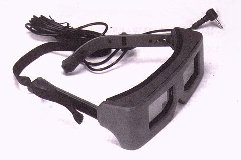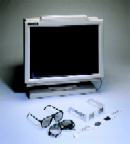
All at once - Stereo-3D in a Nutshell
updated: Feb/17/98

| Content: |
| What is Stereoscopic-3D? |
| Electronic devices for Stereoscopic Vision |
| What you need |
|
|
Stereoscopic or binocular vision was invented by nature hundreds of millions of years ago. Humans and many animals (especially the hunters) have two eyes which look in the same direction. (Some animals have two eyes on the sides of their head to get a wider field of view - especially the hunted). Two parallel aligned eyes deliver two slightly different perspectives of the same scene. The nearer an object is to the eyes the more different are the two images of it. From the difference between the two images the brain can calculate the distance of each object. 3D-vision is all about information, it's food for the brain!
Stereoscopic 3D vision is an important sense, comparable to the ability
to see colors. 3D is not just a gag or a short lived fashion as you
read in 3D-device-reviews sometimes. It's a question of life and death.
An ape who can't see Stereo-3D will soon drop to death when jumping from
tree to tree. A predator who can't see Stereo-3D will miss his bait. Stereo-vision
is vital in many human professions. Without it you might never get a pilot-license
and you're certainly not becoming an astronaut or a circus trapeze-artist
or or or...!
Electronic 3D-glasses are worn by scientists, engineers, architects,
surgeons and by people who steer little cars over the surface of Mars!
<g> Without them they couldn't do their job right!
There are at least three reasons why Stereo-3D hasn't yet become a standard in movies, television, photography and computer software:
1.) technical problems, including ergonomy issues
2.) cost
3.) lack of hard- and software-standards
Stereo vision is not just about two eyes. The most important role
is played by the brain. There are lots of people with two healthy eyes,
but their brain can't merge the two perspectives into one true 3D-sense
of vision. If you can't tell much difference, when watching 3D-material
compared to 2D, you might consider seeing your doctor and asking for a
stereo-vision test.
The ability to see Stereo-3D is developed in early childhood. If this
critical phase is missed, due to eye problems at that time, the child will
never see real 3D in his life, even if the eyes are treated successfully
later.
If your young child has eye problems, especially in case it squints (cross-eyed), get treatment immediately or this vital brain-function might be lost forever!
Don't let your young child use any of the stereo devices discussed on this website. Computer generated Stereo3D often contains errors and there are ergonomy and other health issues, like the risk of epilepsy attacks due to flicker. Your child has to learn seeing stereoscopic in the real world first!
Check the Vision3D website for stereo-vision basics and all the medical issues.
|
|
For Stereoscopic-3D you'll need special Stereo-3D software in any case, whether it's photography, film, tv, video or computer software. You will never get a real 3D experience out of standard material. There are products which claim to do this, especially pseudo3D-television devices, but those offerings are bogus! - You can't get 3D out of thin air.
There are basically two different types of electronic Stereo-3D-devices.
1) Devices which actually produce an image by themselfes -> VR-Helmets/Head
Mounted Devices
2) Glasses which just influence the way you see the image on a standard
monitor -> Liquid Crystal-Shutterglasses/Polarization Glasses
|
|

These are basically wearable monitors. To allow stereoscopic vision
there is a little LCD or CRT monitor for each eye. Consumer products like
VFX-1, i-glasses or Cybermaxx have two LCD monitors with an effective (!)
resolution of 263x240 pixels each (claims of higher resolutions are misleading).
There will be next generation products featuring higher resolutions soon.
In addition these helmets have a headtracker (which replaces or complements
keyboard, mouse or joystick input by head-movement) and some stereo-headphones.
The hard- and software compatibility of such devices is good, since they don't need special graphics-modes or driver software for stereoscopic vision. (They still need genuine stereoscopic applications or games !!!) Drivers for headtracking are required though.
Visit the HMD comparison chart.
|
|
 |
 |
| Shutterglasses: shutter (light blocker) in the glasses | ShutterScreen plus polarization glasses: shutter (light blocker) on the screen |
Shutterglasses and Shutter-Screens are used in conjunction with a normal cathode-ray-tube-monitor or -projector. Just like the one you're most likely watching at in this very moment. There is no way to make them work with a LCD-monitor or LCD-projector.
LCD monitors, notebook-screens and LCD-projectors require special passive polarization solutions which are not discussed here.
The two images required for stereoscopic vision are displayed on the standard monitor by turns. For a fraction of a second the image dedicated to the left eye is displayed, after that the image for the right eye appears for the same duration of time and so on. The job of the glasses is to prevent the left eye from seeing the image dedicated to the right eye and vice versa.
To do this the light is blocked by an LCD-"Shutter". There are two ways to do this. One way is to place the shutter on the monitor and watch it through passive, non-electronic, polarization glasses. The other way is to built the shutters into the glasses. These so called shutterglasses are cheaper than a polarization add-on for the monitor. All consumer solutions use shutterglasses.
Shutterglasses are unrestricted in terms of resolution and color depth.
There are several ways to connect shutterglasses to the computer system.
1.) ISA-card
2.) Parallel or serial port
3.) Dedicated 3D-port on the graphics-board (professional solution)
4.) VGA-pass-through-cable (with or without special features)
For non-professional use I recommend glasses which have a VGA-pass-through
controller. These controllers are installed between the graphics-board
and the monitor. My recommendation might change in favor of a "dedicated
3d-port on the graphics board" in the future, but the software support
for consumers isn't satisfying yet.
|
|
Hardware compatibility is all about VGA-graphics-chipsets.
In order to make shutterglasses work there must be a page-flipping or interlace image on the screen!
From the Stereo-3D-compatibility point of view there are 3 types of VGA-chips
1) VGA-chips supporting interlace and page-flipping: Older chipsets,
most 2D and 2D/3D chipsets -> almost all S3, Tseng, ATI, ALS, Cirrus
Logic, Matrox and more.
2) VGA-chips supporting page-flipping only: Newer chipsets,
some 2D/3D and some 3D chipsets -> Rendition, RIVA (???)
3) VGA-chips supporting neither: Voodoo Graphics &
Voodoo 2 (software page-flipping might be possible - in theory)
With a common chipset of type 1 you're on the safe side. A chipset of
type 3 can't do Stereo3D by itself, at least not in hardware. It needs
an active, external sync-doubler glasses-controller, which generates
page-flipping by itself. Sync doublers are used in professional products
and in one consumer product: H3D!
There might be software page-flipping drivers for Voodoo and the like
in the future!
DOS-stereo-software works on almost all (type 1 and 2) VGA-chips
by using standard VGA and VESA page-flipped modes.
The Windows-desktop work on a limited selection of VGA-chips
only, because chipset-specific drivers are required.
Choosing the right Monitor
Stereo-3D software reduces the refresh rate each eye sees into half.
60 Hz are slashed down to 30 Hz in effect. Therefore I recommend a refresh
rate in exceed of 100 Hz. Use a program like Scitech's Display Doctor
and it's UNICENTR-util to see what vertical frequency your monitor can
handle. Set the resolution to 640x480 and increase the frequency. If you
reach 100 Hz or more you're monitor is adequate. 120 Hz or more are good.
Do not believe the documentation/specs of your monitor!!! Be careful not
to run your monitor on a frequency it can't handle for a longer time. When
the image vanishes, reduce the frequency immediately.
Another important issue is the persistance. The shorter the persistence
the less ghosting will occur. Ghosting is
THE major drawback of shutterglasses.
|
|
The highest (consumer) software compatibility is achieved by systems using a plain, no-catch VGA-pass-through-cable controller. Consumer products with such an controller are: i-Art VirtualEyes, APEC VR97, (Cyberstuff Cyber3DVisor ?). More such devices are scheduled for a 1998 release.
The Kasan 3D-Max with it's ISA-card-controller offers good software-compatibility too.
Devices with a parallel or serial controller are in the midfield. With the right driver software they can do a lot of things too.
There are several graphics boards with integrated glasses-controller with different characteristics. The Canopus Total 3D behaves like a VGA-pass-through-controller usually, but refuses to work in some instances. Boards with an integrated VESA3 miniDIN3 connector are future-proof, but pretty much useless (at least for non-professionals) at the moment (Feb. 98).
There are two consumer shutterglasses which are limited to proprietary (native) software: Stereographics SimulEyes (called miro fanatix in europe) and H3D Eyewear. To make them work with non-native software some serious hacking is required.
For detailed info on hard- and software compatibility I recommend the following sections of this website:
Shutterglasses Comparison Chart
Shutterglasses Controller Comparison
Chart
Shutterglasses Driver Comparison Chart
Software Charts
|
|
|
|
A HMD, like the VFX-1, saves you from many hassles connected to shutterglasses
and adds headtracking, but it's more expensive, less comfortable and has
a lower resolution.
Hope that helps!
Brand and product names are trademarks or registered trademarks of their respective holders.
The author can not guarantee the accuracy or topicality of the information given on this page.